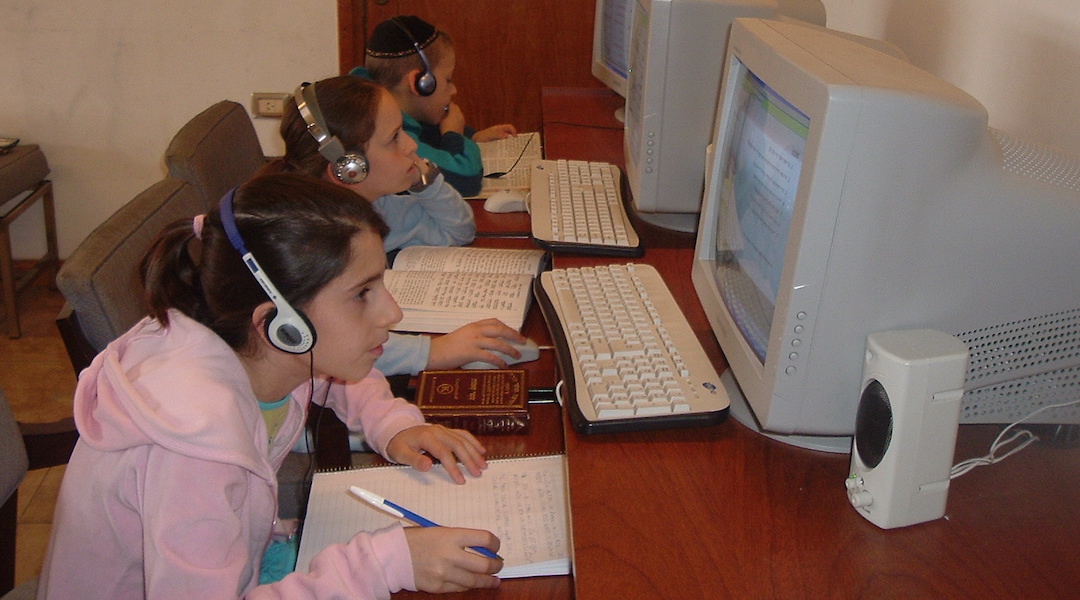 Chabad children in Argentina study in the movement’s online school in 2007. During the new coronavirus outbreak, the school has offered guidance to other Jewish schools transitioning to remote learning. (Courtesy of the Nigri International Shluchim Online School)
Chabad children in Argentina study in the movement’s online school in 2007. During the new coronavirus outbreak, the school has offered guidance to other Jewish schools transitioning to remote learning. (Courtesy of the Nigri International Shluchim Online School) Like so many millennials, I bear my student debt like an albatross, branded with the lifetime shackles of an Ivy pedigree. Time has not shrunken my debt; rather, it has quadrupled what my initial principal once was. Homeownership is no sooner in my future than my two-decades-long dream of one day trekking across the vast landscape of Iran wearing my American-Jewish identity with pride.
A few weeks ago, the United States came to a grinding halt. A seemingly secure workforce found itself homebound, along with all of America’s youth under the age of 18, with school closures. Never in our history has the U.S. seen this level of national peril − and unlikely opportunity. While the nation struggles to flatten the coronavirus curve, I offer the following proposal:
The six-month deferment of student-loan interest outlined in the CARES act may provide immediate relief to millions, such as myself, whose monthly disposable income post-loan payment is meager at best. However, we are experiencing a unique time in our history, which might allow for a much more impactful program to benefit numerous sectors of our society now, and for the long term once we return to the workforce.
With a large portion of America’s workforce now working from home and almost all of America’s school-age children attempting to learn remotely, imagine an initiative that matches adults with student debt with children from elementary to high school in an online tutorial program. This program would be designed to augment the virtual learning experience and reinforce essential skills such as reading, mathematics, social studies and science. Homebound lawyers could become civics teachers; engineers become math and science tutors; writers become English teachers; athletes become health coaches; graphic designers become art teachers; musicians and composers become music teachers etc.
Never have we faced such a pandemic in modern times. However, we are presented with a unique chance to transform the shelter-in-place mandate into an opportunity not just to maintain, but to augment the virtual educational experience of America’s youth − specifically high-risk students − while simultaneously helping college graduates who bear substantial and unsurmountable student debts as the results of their investments in their education.
How the initiative works
College graduates and K-12 students will both enroll in this program and be assigned an identification number issued through the Department of Social Services. For each verified hour an eligible college graduate provides pro bono assistance to a student, he or she would receive, for example, a $50 credit toward his or her student loan principle. Assuming a college graduate provides five virtual tutorial hours weekly, that is a monthly student loan credit of $1,000. With an average student loan debt of $37,000, a graduate would have the opportunity to “work off” his or her federal loan in a few short years, compared to the current 20-plus-year average − all while providing invaluable assistance to other American students both during this unprecedented time and after.
With one high-school student dropping out every 26 seconds, the effect of such a program could be profound − especially given that school closures risk resulting in tremendous declines in student learning and access to tutorial services. In short, as waves of graduates successfully absolve their debts and provide an invaluable public service, new waves likely would follow in their footsteps, creating a new public-service paradigm where giving back becomes part and parcel of becoming a wage-earning member of society.
The advent of the coronavirus has been devastating nationally and globally. However, it is indeed woven into the fabric of American identity to build bridges when roads are collapsing. The implementation of the TOUCH Act could be the solution to both the crisis of student-loan debt and the tremendous challenge to the preservation of quality education in a time of ubiquitous school closures and potentially beyond, as we create a new “normal” and collectively redefine personal investment in the education of America’s youth.
Lisa Ansell is the associate director of the USC Casden Institute























 More news and opinions than at a Shabbat dinner, right in your inbox.
More news and opinions than at a Shabbat dinner, right in your inbox.